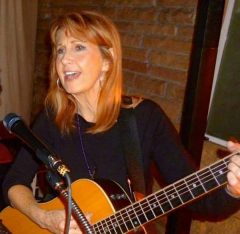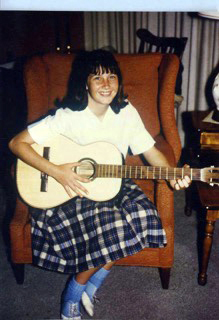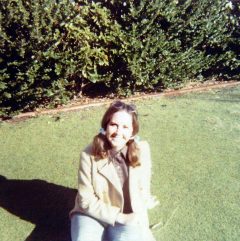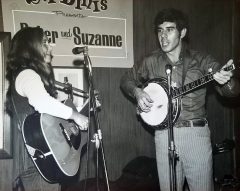Featured Stories
Suzanne Shea: When an Irish Heart Is Singing
The rich, bold aroma of coffee being brewed and served by a bevy of baristas busy at work behind the counter; the sounds of sweet laughter drifted throughout the ebb and flow of conversation greeted me as soon as I entered the café, located one block away from the trolley line I had used to whisk myself across town to arrive at my destination in La Mesa. For it was on this brisk, winter’s morn that I was finally able to meet up with local performing artist Suzanne Shea, who was gracious enough to take time out of her day to discuss her music and most fascinating back story about her personal journey and unwavering loyalty, dedication for her love of song and expression of self that has uplifted her and the lives of countless others for many seasons.
When Shea arrived a few minutes later, I was immediately met with the kind of amiable warmth, usually reserved for the closest of friends. Even though this was my very first time coming face to face with her, it felt as if I had known her my whole life. Perhaps my own experience, upon meeting the singer, somehow reflects the same sentiments of many who are well acquainted with her–that she is the embodiment of generosity and kindness. All first impressions aside, one would be hard pressed to find a nicer, more genuine spirit than Suzanne Shea.
If one were to follow the natural progression of Shea’s life–from her birth to present day–all markers would successfully trace the path back to where and how music became the determining factor of who and what she represents in her ongoing quest to make music and joyously share it with others.
Born in San Diego on April 22, 1950, at precisely 7:20 in the evening Shea was destined to make music her life’s passionate pursuit, given the notion that she sprang from the womb right into the cradle of an environment that was overflowing with an abundance of song and surrounded by those who loved and embraced it. Shea recalled those early years of her music-infused childhood with much fondness.
“I grew up with a mom and dad, two older sisters and an older brother, all of whom loved music. Ours was a music-filled household. Dad was from a large Irish family that included nine kids. There was always music around when he was growing up. He was constantly singing fun, little Irish tunes to us when we were children. All the Shea aunts, uncles, and cousins would meet up at his sister’s and her husband’s home on Mission Bay in the summertime, on the weekends. At night everyone would be out there, sitting on blankets, with all of us singing ‘Moonlight Bay.’ I truly love that memory of my life.”
Music lauded in the Shea Family was not just limited to carefree weekends assigned with relatives; it also reverberated quite frequently throughout their homey abode. Even when Shea assisted her mother with chores around the house, she remembered how much her mother delighted in the opportunity to sing songs lifted from the golden era of the Great American Songbook–the ’20s, ’30s, and all the way through the 1940s.
“Mom loved to sing! When my sisters and I would help her out with the dishes, she’d sing all those great old songs she had grown up with. We’d sing along, too, and try to harmonize with her on them,” said Shea.
Those endearing moments shared among Shea and the women in her family had left such an indelible impact on her that, even to this day, she entertains those residing in senior retirement homes with the same repertoire of musical gems first introduced to her by the matriarch of the Shea clan. She also gives much recognition to her three siblings, for whom she credits having the biggest impact on her “deep love today for many of the classic songs of the ’50s and ’60s.
“As my sisters and brother hit their teens, they started buying records–45s and albums. I’d learn tons of songs from hearing those records being played on our hi-fi record players and the radios in their rooms, all the time,” explained Shea. “Around the age of eight, I used to sneak into my sister Sally’s room, after she had fallen asleep, and I’d get her newest gadget–a portable radio with a leather handle. I’d take it to my room, tune it to KCBQ, put it under my pillow, and fall asleep every night to Top 40 songs.”
Amidst all the music and harmonies surrounding Shea, the decision for her to eventually take up a musical instrument and learn how to play it came to fruition. When she was ten years old, a friend of hers was taking accordion lessons, so she asked her parents if she could try that out as well. By the fifth lesson, however, she found that she had absolutely no interest, whatsoever, in reading notes or practicing scales. Her ear was strong, and soon she was improvising her own tunes, while pretending to read the notes when she attended her weekly sessions. Shea was firmly reprimanded by her instructor, as he made it succinctly clear that she had no future in music, unless she first learned to read it. His terse advice did not sit well with the young student, so she decided then, it was time to cease her studies and return the rented accordion back to the shop, promptly halting the music lessons. Satisfied that she had made the right decision, she went back to her other hobby: ice skating.
By 1963, folk music was in full swing, thanks to the Newport Folk Festival, which saw the likes of such renowned acts as Joan Baez, Sam Hinton, Jack Elliott, and Bob Dylan take the stage. Ultimately, it had a very positive effect on musicians influenced by this genre of music and was enough of a creative magnet and impetus to propel burgeoning artists to incorporate folk music into their earnest attempts to make it as much a part of their own signature sound. The same could be said for Shea. After trying out a friend’s guitar one afternoon, she felt an immediate connection and knew in her heart that the guitar was the instrument she would learn to play. For her 13th birthday, her parents gave her a $19 “Ed Sale” guitar. She was so eager, enthusiastic to master it that she’d spend hours alone in her bedroom, after school and on the weekends, teaching herself basic chords. The steel strings and poor “action” of those strings made it very painful for her to play, causing her fingertips to bleed. This minor inconvenience never deterred or discouraged her, as she realized, over time, she’d develop the callouses needed to protect those precious digits from further discomfort. Shea was soon able to move from one chord quickly to the next, executing the perfect rhythm, and began singing along while tackling the task at hand.
“There, it was! My heart had finally found its road,” exclaimed Shea.
Shea finally made the monumental leap from practicing guitar chords in her room to eventually landing her very first professional music gig when she was only 16 years old. She looked back on this moment that showcased her musical performance with a friend from high school.
“My first paid gig was at Parkway Bowl in El Cajon. Rich Gamble, a Grossmont High classmate, and I worked together as a duo in a folk music room they had set up in the venue somewhere,” said Shea. “We sounded, ah, well, ‘new.’ We sucked, I’m sure. But, I remember it was so much fun! We got paid 25 dollars each to play.”
In 1969, when Shea was 19 and securing solo bookings in small coffeehouses, she met local multi-instrumentalist Peter Varhola. They were both students at Grossmont College, and each was performing in the school’s talent show that same year. After the production was over, Varhola introduced himself to her and asked her if she’d be interested in being part of a musical duo or trio format. Her response was, of course, an affirmative “Yes!” Varhola, who had a great deal of music theory knowledge, recognized a natural propensity and talent in Shea–not only for her proficient playing and singing skills, but, just as important, her charisma, upbeat personality, and her ability to captivate an audience. They were also compatible as a duo, which made their partnership a very good fit, musically.
Shea and Varhola were steadfast in their practice sessions and, in time, set up shows at various military bases, coffeehouses, and pizza parlors around town. Once they had established themselves as a reputable draw, they secured a formidable, steady-paying gig at McDini’s, at Third and G Street in downtown San Diego. This happened while the city was a haven for businesses that catered to military personnel, including tattoo parlors, strip joints, and dive bars. It was still several years away before the area underwent a massive redevelopment renaissance that witnessed the influx of exclusive, high-rise condominiums, specialty boutiques, and fine dining restaurants–a direct result of the commercial real estate market boom which helped bring about all the downtown property construction into the forefront of the late ’80s and early ’90s.
“Our audience at McDini’s was mainly homesick military guys, who would come in for a drink and a bite to eat but for the music, too. They would always come up to tell Peter and I how much they appreciated our songs–not only the ‘new’ folk music but also for the classic country and bluegrass tunes, as well, that they missed back home,” recalled Shea.
A few months later, Shea and Varhola were performing at a special event at LAX, for TWA Airlines, when Lady Destiny had her way with them. A gentleman by the name of Joey Gallo was walking through the terminal when, suddenly, his attention turned towards the sweet, melodic refrains of music in the distance. A preeminent, popular San Diego entertainer who, during that era, was the top draw at Reuben’s Harbor Island (in the same location that Island Prime stands today), Gallo was very impressed with what he was hearing. His curiosity needed to be satisfied and so he made his way over to where Shea and Varhola were playing, introduced himself to them and handed them his business card. Not only was Gallo a perennial in the San Diego nightlife scene, he was also in charge of booking all the entertainment acts for Reuben’s Restaurant, a prestigious nationwide chain of fine dining restaurants that offered live entertainment in its lounges, five to six nights a week. Before long, the duo began a four-year residency with the three Reuben’s establishments in San Diego, Newport Beach, Irvine, Riverside, and Atlanta, Georgia.
Alas, the adage “nothing lasts forever” became part of the musical equation for the duo, as their professional partnership came to an end after four years. Although Shea and Varhola went their musical ways, they continued to stay in touch with each other throughout the years, a bond created and strengthened by their mutual love for friendship and song.
(Suzanne Shea, Part Two, will appear in the April issue of the San Diego Troubadour)










